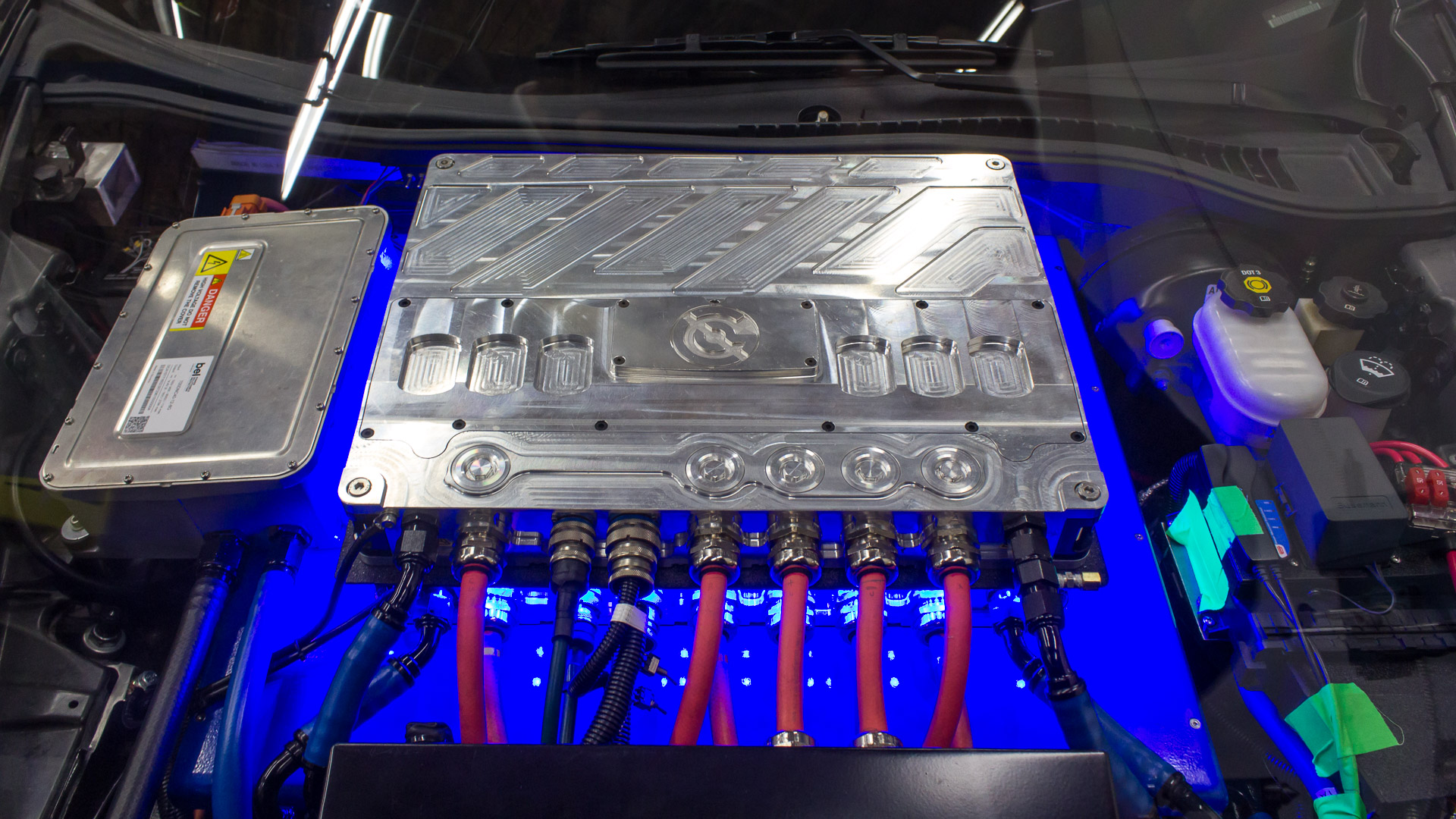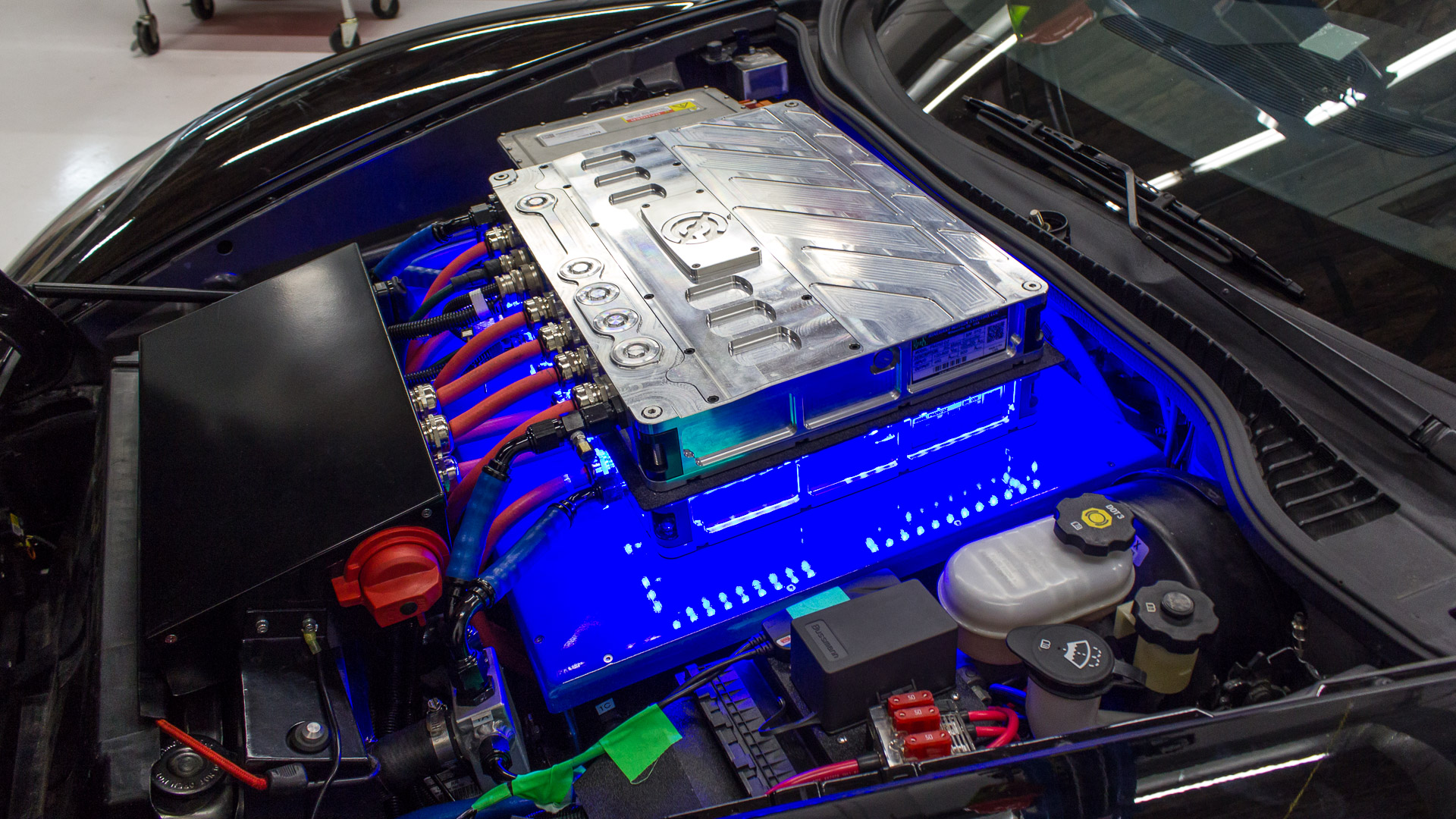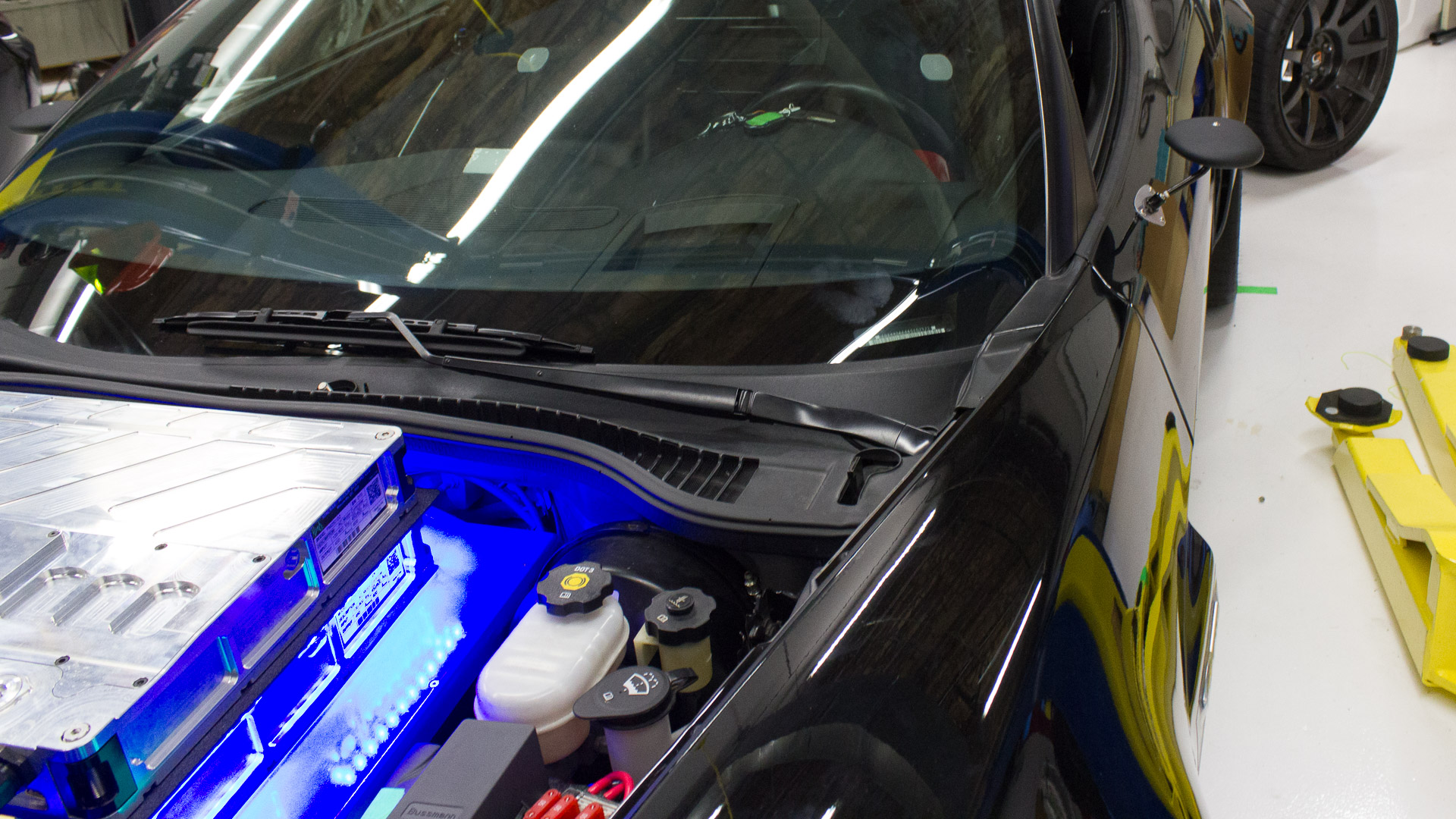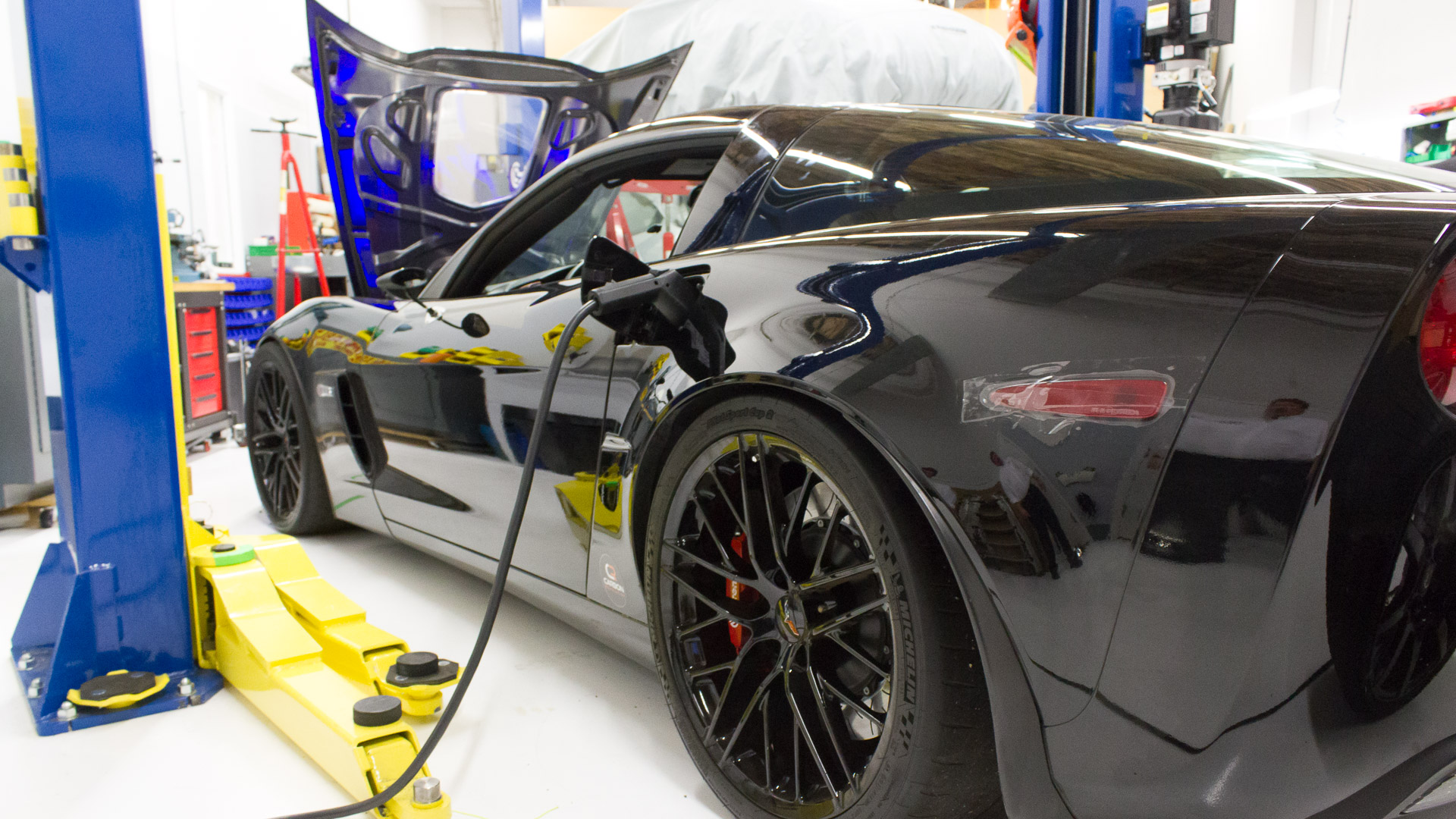Meet The Mad Scientists Just Getting Started With 209 MPH Electric Corvettes 28 Mar '17
Most Corvettes are fast. That’s the whole point. But not all Corvettes can do 209 mph while breaking records because they run purely on—get this, and be ready to horrified if you’re a Corvette purist—electricity. That’s what the Corvettes from Genovation Cars do. And they come from a humble shop in Rockville, Maryland.
I went there to see how these cars are made, including the planned $750,000 C7 Grand Sport-based electric car as well as an aspirational all-wheel drive supercar built purely in-house. It turns out big things come from small places. Tucked in the back of a typically nondescript business park in the D.C. suburb of Rockville, Genovation is run by a fellow called Andrew Saul. The CEO himself met me at their front door and gave me the tour of their facility. Well before the black on black on black Z06 broke an all-electric standing mile record by topping 200 mph on Kennedy Space Center’s 3.2 mile runway, Andrew and his colleagues have been tinkering with electricity. Littering their shop are a half a dozen non-petrol-powered machines.
Genovation got their start building a modified electric Ford Focus, dubbed the G1, meant for fleet use. A local county government was slated to buy a bunch of them when the economy tanked in 2007. After the recession hit, budgets were slashed and the mayor pushing the project was not reelected.
The conversion vehicle industry was also affected when the Nissan Leaf arrived in 2010. Suddenly, you could buy a post-rebate $20,000 EV with a warranty versus spending around the same to convert a used vehicle with no warranty and typically less range.
Some of the G1 Focus prototypes sit under a cover in Rockville and you’ll also find a working electric-converted BMW Z4 taking up some real estate. The small company decided to begin research on producing their own vehicle. The result was a whole lot of data and a wind-tunnel model called the G2 which has a coefficient of drag of just 0.2 Cd. It was through the G2 project that they enhanced their technical capabilities within the industry working with companies like Dana, Metalsa and Tata Technologies.
As they attended conferences and trade shows, it became evident that there was a confluence of new technologies and components that could enable the development of an EV Supercar. So they decided to put the G2 on the shelf and focus their next project on something else: speed.
Enter the GXE

The choice of starting platform for Genovation’s next car was pretty easy: they went with the new-at-the-time C6 Corvette. The C6 Z06 Corvette’s aluminum frame with carbon fiber floor was very cutting edge when it came out in 2006.
Plus, Andrew noted, the Corvette is such an American icon that reinventing its drivetrain with the latest cutting edge—American designed EV technology—seemed to make sense.
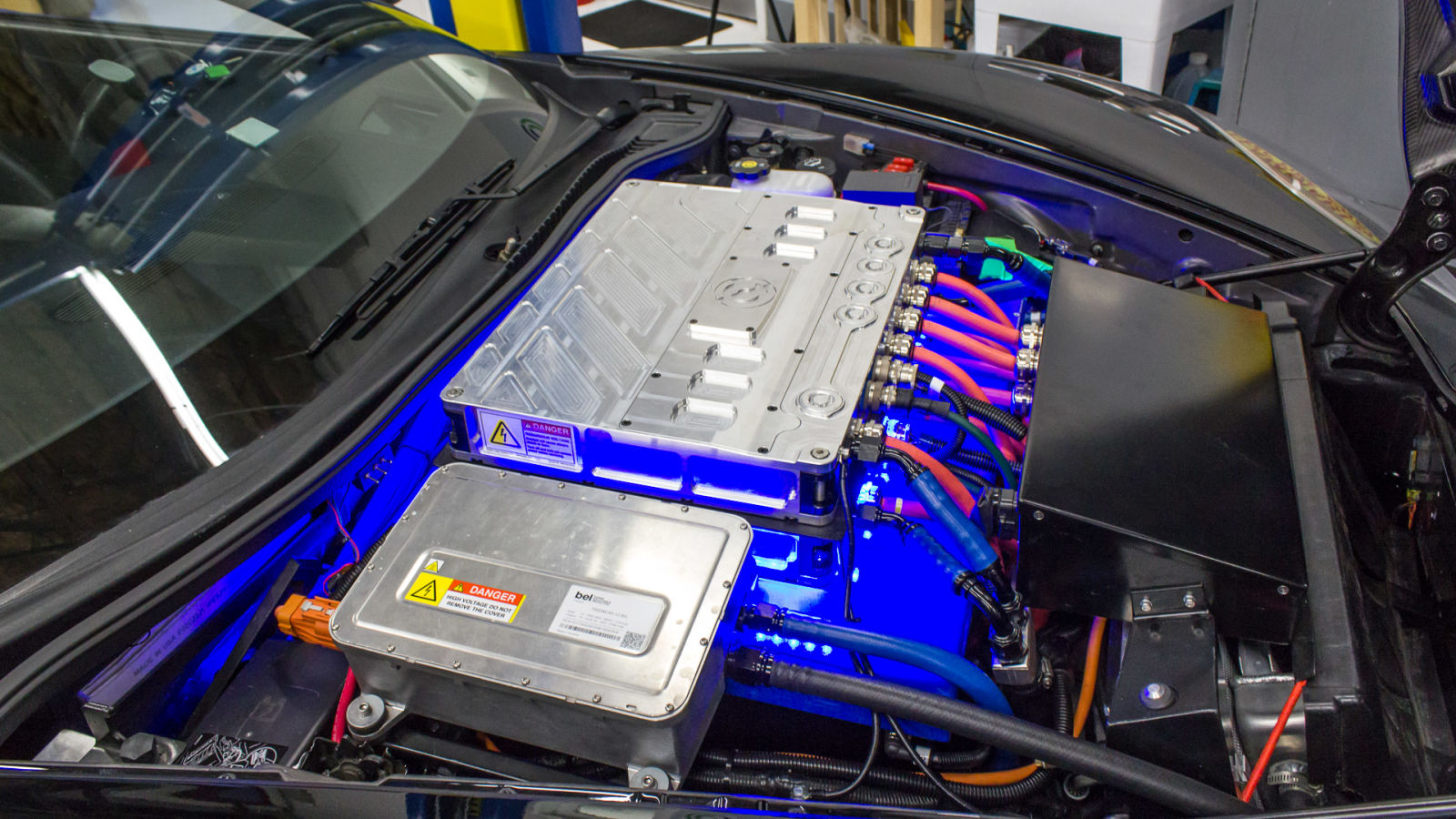
With a goal of starting from scratch, Andrew acquired a C6 development chassis (no. 16 of 44) from Dana Corp, the original manufacturer of the C6 chassis for GM. It was about to head to the smelter but was given a reprieve and Genovation had two weeks to get to Kentucky with a trailer. However, they had to sign an agreement not to put a gas engine in it. Boom, done.
Andrew told me that the goal was never to break records; they just “wanted to change consumer perceptions of what an EV could be” by building a manual tranny prototype car that you could actually enjoy driving on the street and still take to the racetrack for a day of fun. Looking to keep things green, they found a composites company to manufacture soy resin-based body panels. Instead of investing in expensive CAD designs, they made their molds directly from a C6 owned by their CEO.
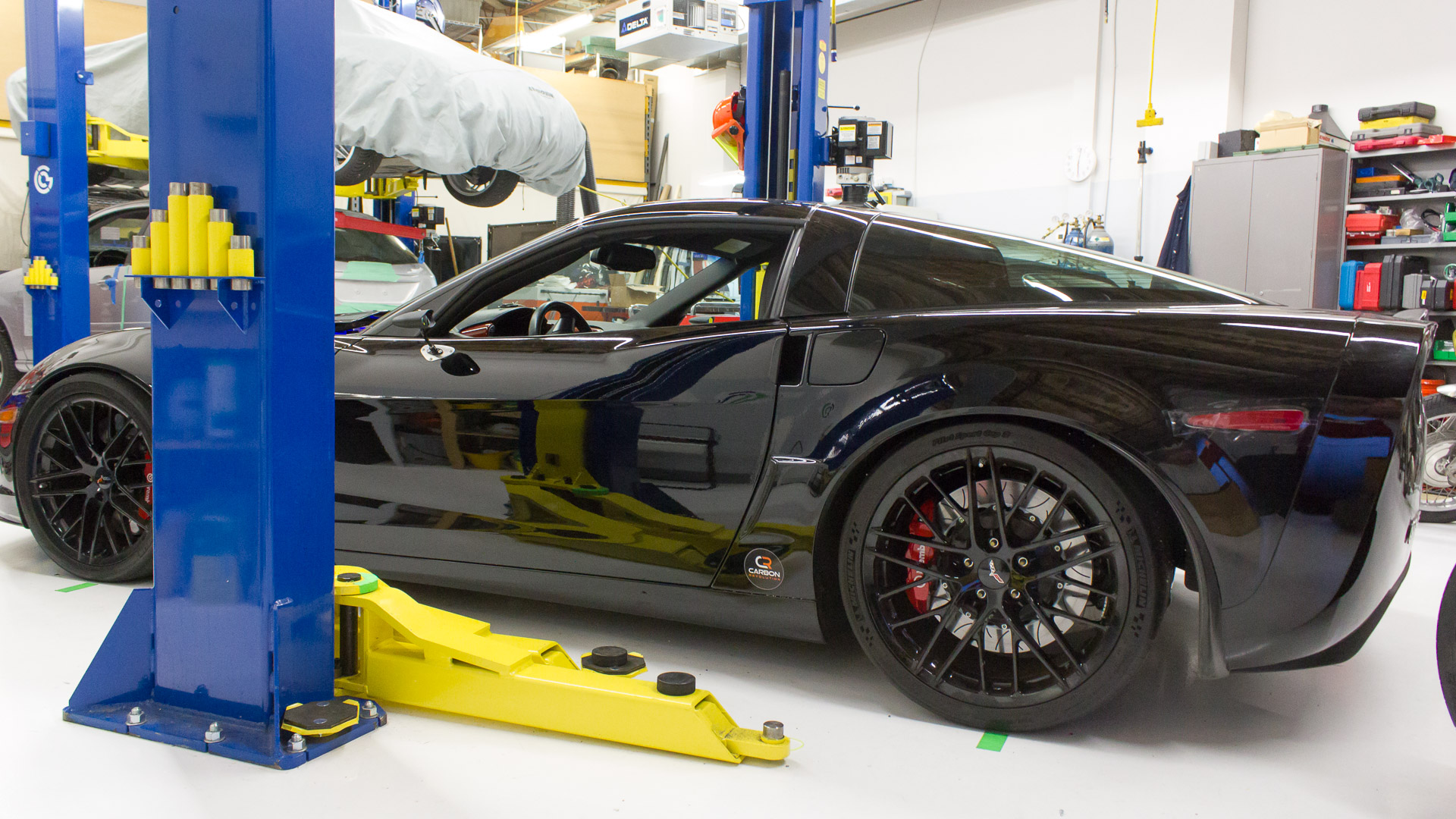
A noble goal, but eventually it just became clear that it may be easier to start with a complete car. That original prototype shell still greets visitors to Genovation’s shop. Andrew and company went on to purchase a used C6 Z06—already modified with a supercharger and putting out around 600hp to the rear wheels.
After the engine and blower were removed, they were replaced with a developmental dual motor setup with battery packs. Basically, there are two motors operating on a single shaft. In case you were wondering, they considered adding two more motors to power the front wheels and make it AWD but the weight and added complexity just wasn’t worth it. More on that in a bit.
It’s been widely reported that the record-setting car kept its manual transmission in lieu of some sort of fancy single gear setup. You’re damn right it did. The car initially had a clutch from the mighty ZR1, but has since been upgraded to a Monster clutch, rated up to 1200 HP to deal with the instant power and torque of the electric motors.
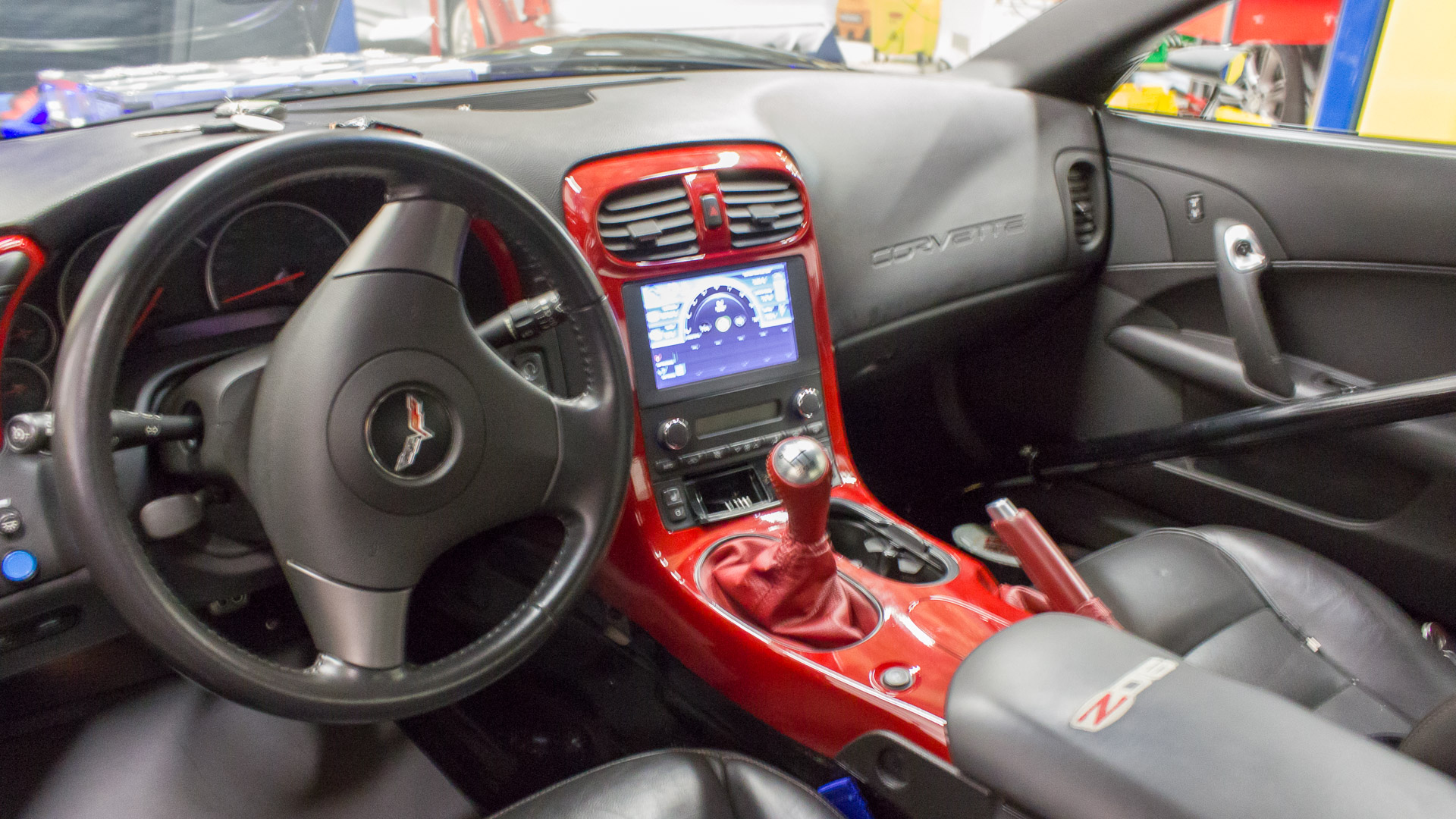
The GXE’s software was calibrated to help manage the torque delivery and optimize speed and traction using the manual tranny—the car even has a shift light intended to help optimize shift points based on state of charge and battery pack voltage. Aside from the uprated tranny, the differential, half shafts and drive shafts are all beefed up to manage the instant torque. On the outside, the current car has a ZR1 hood so you can see the components up front, complete with some cheesy neon accents to make it look a bit fancier.
While quite a bit of work was done at the Genovation shop, this wasn’t a solo project. Some of the work was done at Tony’s Corvette Shop in nearby Gaithersburg, MD which is one of the premiere Corvette-focused shops in the country along with some additional “technology assistance” from Stafl Systems and EVDrive.
The car was recently dyno’d at 700 HP and 650 ft./lbs of torque and has an estimated 150 mile range.
The Record Runs
Genovation first got nationwide attention when they set the top speed world record for a road-legal all-electric car, reaching 186.8 mph in the GXE. Rewind back to the winter of 2015 and Andrew was looking for a place to test the nearly complete prototype. Some options cropped up, including a stretch of Nevada highway, but it was narrow for his liking.
Enter Johnny Bohmer, owner of one of the current fastest street legal cars, the 1800 HP, 283 mph Ford GT nicknamed “BADD GT.” Johnny not only suggested using Kennedy Space Center’s 3.2 mile runway—which is 300 feet wide and only changes elevation .25 inches over the course of the run—but also drove the GXE and had input on the GXE’s record runs.
For example, during the first round of testing they used stock wing mirrors, but Johnny noted that over 200, those would cause considerable drag. So, Andrew and the team switched to a more aerodynamic setup that you see on the car now. Other than that, the body remains largely stock, only sporting some “helicopter tape” over the seams, indicator lights, etc. Anywhere with a rough edge.
Inside, the interior is pretty much stock, save for a custom roll cage, required by Space Florida and the International Mile Racing Association for cars that surpass 200 mph.
Once the 2015 run was complete, and the record broken, the car still indicated a range of 100 miles. And, while a gas-powered car would be incredibly hot after a run like that, the battery and motor area under the hood was just barely warm to the touch.
Andrew and company just took the car back to Florida in February, again with Johnny at the wheel, and hit a top speed of 209 mph and 190.48 mph in the standing mile. There were over twenty other very fast cars at the runway as part of a Festivals of Speed event but the GXE was the fastest street legal car there, only beaten by three Lamborghini race cars.
Perhaps our dystopian all-electric future won’t be so terrible after all.
Version 2.0, The C7 GXE
The current GXE is in a constant state of flux, having been built, torn down, and rebuilt numerous times during the prototype phase. But as you heard here back in October, it is just version 1.0 and is still acting as a test bed for its follow-up: the $750,000 C7 Grand Sport Corvette-based GXE.

Genovation is testing a brand new set of Carbon Revolution wheels from Australia, which drops 10 pounds per wheel of unsprung weight and rotating mass. These weight savings have already helped them reach the targeted 150 miles-per-charge on the C6 prototype.
Genovation seems to be a believer in the “crucible of motorsport” where cars are not driven gently. They plan a bevy of tests for the C6 GXE mule to ensure the viability of future tech to help make the new car better. Andrew hopes to have it at Laguna Seca and VIR this summer; and naturally, he would love to get it over to Europe to visit the Nurburgring. He told me that the battery pack is being engineered to endure at least one lap of the famed track on a single charge.
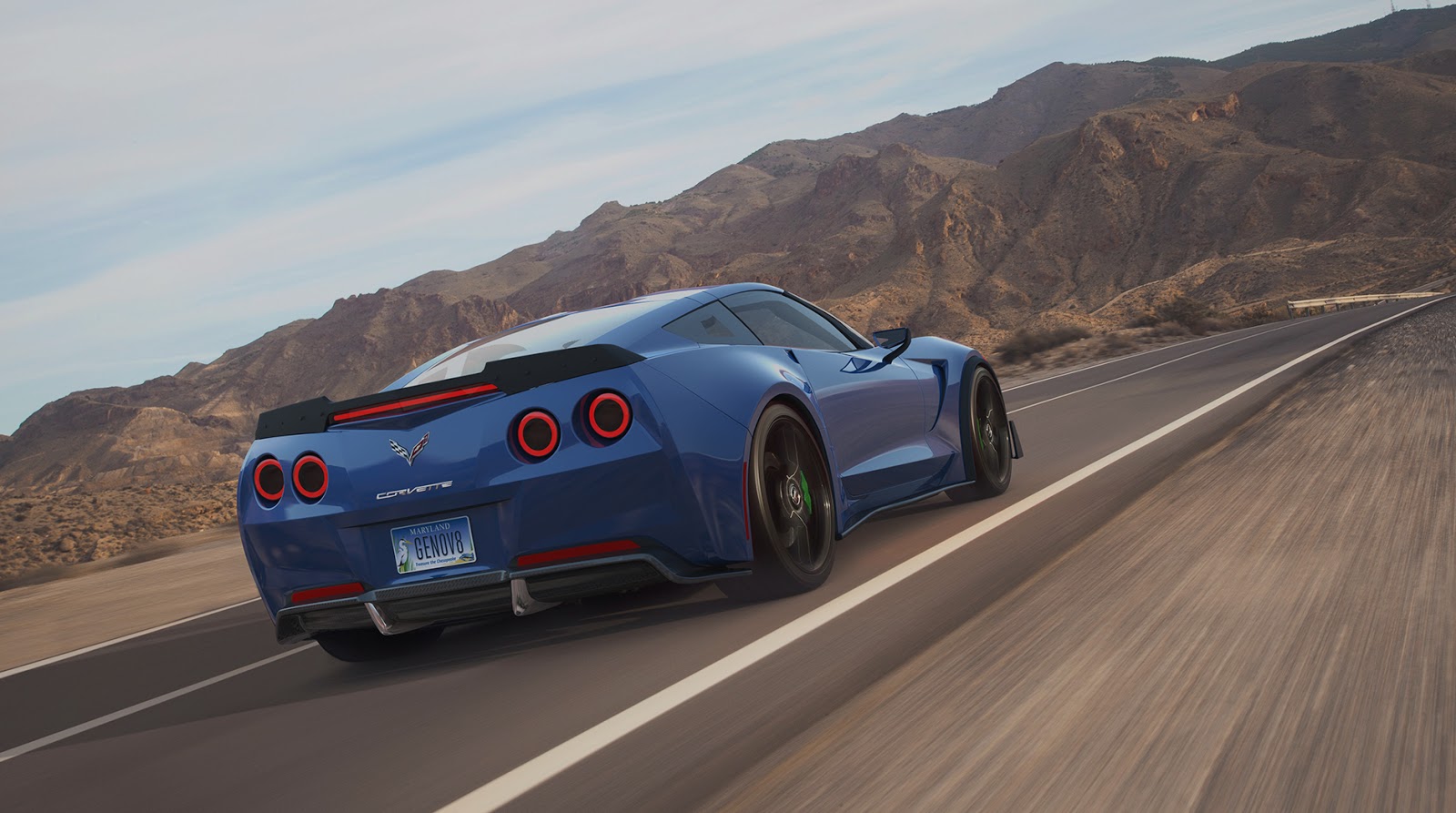
Part of that track-tested tech will be the de rigueur set of carbon-ceramic brakes, something you would expect on a car that costs three quarters of a million dollars. Andrew also said that they are working on a regenerative brake handle which basically functions like a “drift mode” and will charge the battery while doing sweet drifts. Off road use only, of course. This will be tested with the current GXE on track soon. Sign me up.
And even though the GXE doesn’t quite get as hot as a gas powered car, they will also test a trick “cooling loop”. The concept is, you finish your laps and plug the car into a stand-alone system that will basically suck out all the warm coolant from the system while it’s charging, cool it, and replace.
That’s Cool. But $750K, Really?
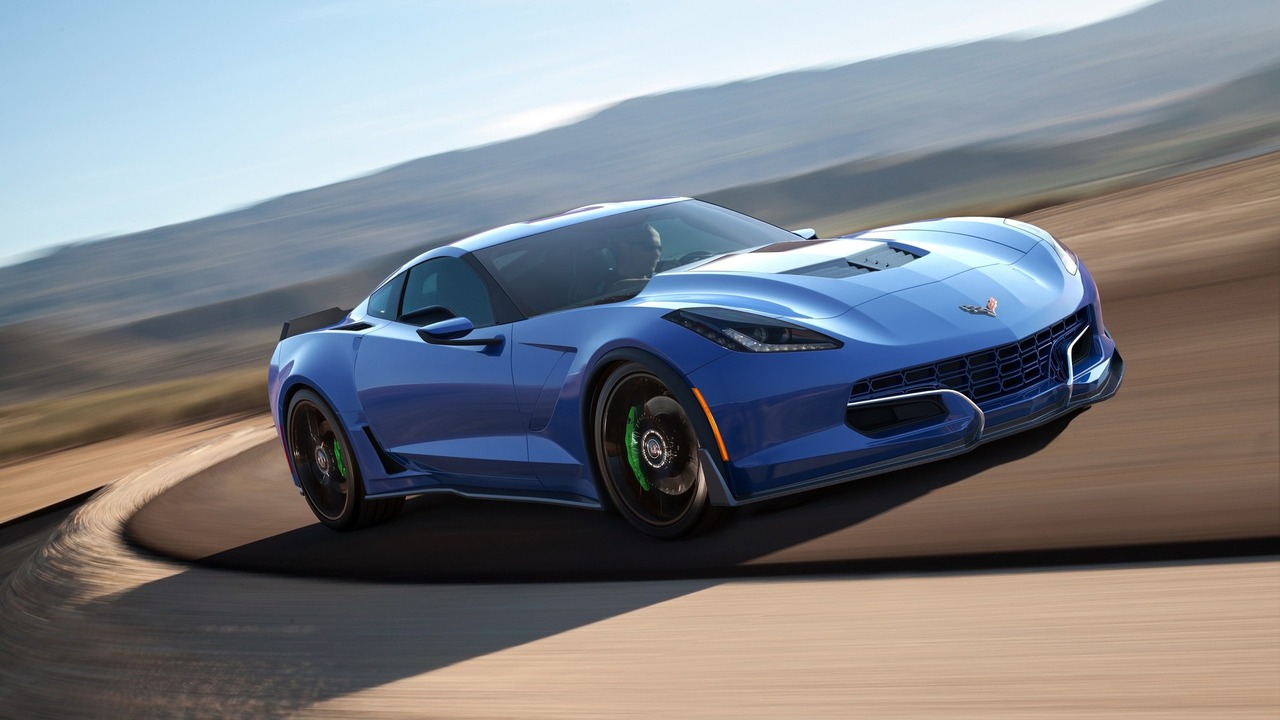
Andrew confirmed what we have heard before—that the new car will require a two-year prototype phase, already underway, followed by a one-year calibration and build phase. Naturally, potential customers will be able to be incredibly involved, choosing colors, wheels, interior, etc. And once one exterior paint and interior color combination goes out the door, that’s it. Each car will be unique. Andrew would like to be the “Singer” of custom electric supercars with a target of four per month in their Maryland shop. A lofty goal indeed.
And yes, deposits are still a hefty $250,000. I asked him to defend their rationale for the $750,000 price tag and he said it all comes down to the relative uniqueness of a GXE. Andrew told me that the price is based on the cost of the cutting edge GXE technology, much of which was derived from F1 and Le Mans racing, as well as the significance of the records the GXE has broken combined with the exclusivity factor.
With only 75 GXEs being built, and with each car having a bespoke personalized interior/exterior color combination, using only high quality materials and the Carbon Revolution wheels; it will hopefully be a special car indeed.
He said that it should compare to something like a Bugatti Veyron, one of the fastest gasoline-powered cars in the world, and significantly more expensive. The GXE—being the fastest street legal electric car and the first to exceed 200 mph—features technology no other street car for sale currently has; and, therefore Andrew believes it should draw a premium. It’s definitely a bold claim.
The price is intended to help fund the development and production of future vehicles, including future GXE variants and other Genovation projects including the aforementioned AWD supercar. Built from the ground up using carbon fiber, Andrew envisions a future where Genovation can produce their own bespoke supercar using technology from the GXE.
That was about all I could get about that particular project; obviously, they have a lot riding on the upcoming sale of GXEs to the public.
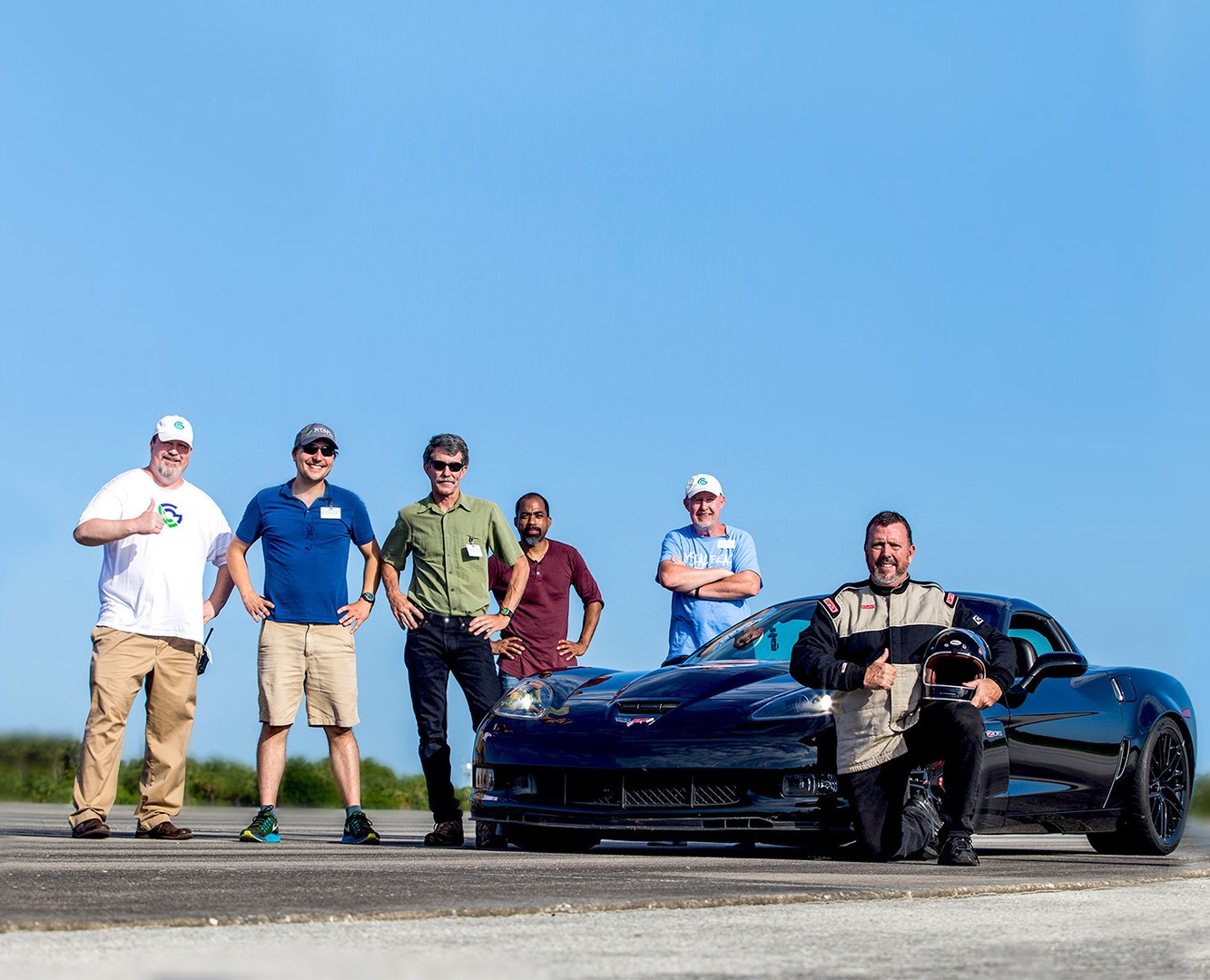
Genovation currently employs just three full time staff members with as many as a dozen others around the country working on various projects. Take a minute to realize just what Genovation is up against. Three full-time staff. Three. Luckily, Andrew said he has received great help from nearby University of Maryland, with engineering students spending time in their shop learning about the future of automotive technology. Genovation is sponsoring research over at College Park in return.
As a Maryland native, and someone who loves to root for the little guy, I hope they succeed. However, while it’s pretty impressive that they have a working 209 mph all-electric, manual gearbox prototype, they have a gargantuan task ahead of them. With such a small staff, they are going to have to put on one hell of a sales pitch to get three quarters of a million bucks from potential GXE buyers.
Regardless, I won’t say no to seat time when the next generation GXE is ready.
William Byrd is the editor of Right Foot Down. Follow him on Twitter.
View the original article on jalopnik.com.
